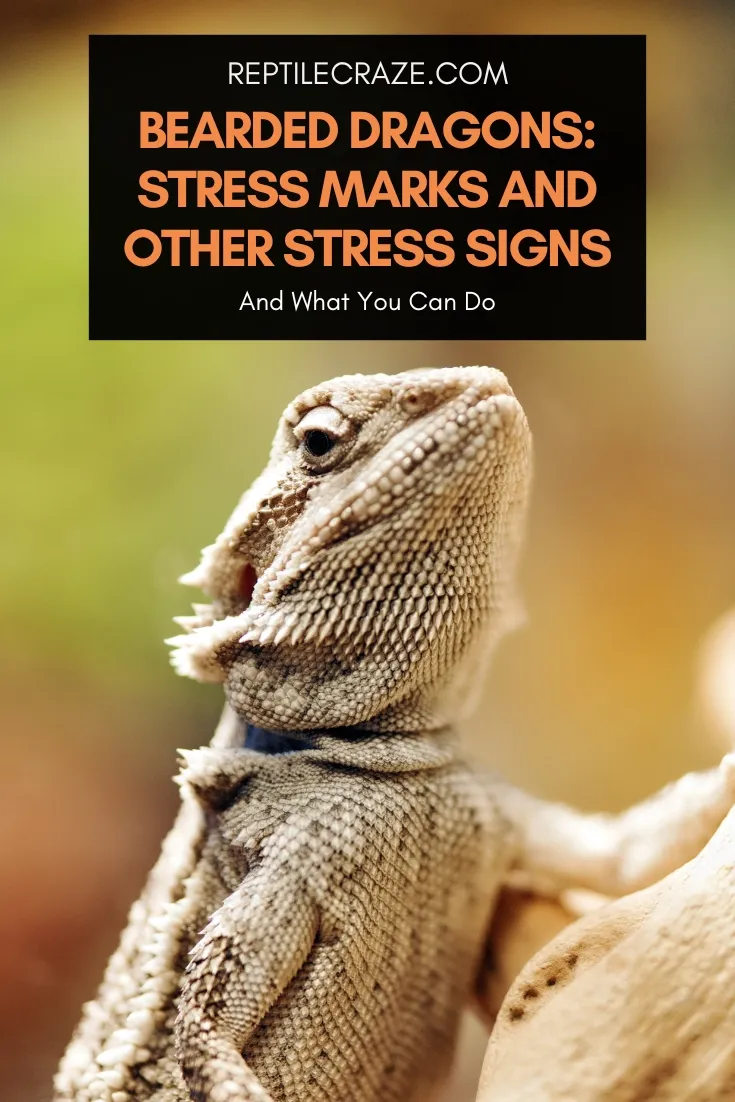
Bearded dragons are interesting and pretty laid back reptile pets. Sometimes though, bearded dragons can get stressed and then develop stress marks or show other stress-associated signs.
Stress marks are dark, in the shape of an oval or line, and can be found on the stomach, arms, legs, or chin of a bearded dragon. Causes of stress for breaded dragons include; inappropriate husbandry conditions or handling, cage mate aggression, impaction, infectious diseases, and parasites.
This article will explain the answers to common questions regarding stress and sickness in bearded dragons (such as those concerning stress marks) and offer some guidance for pet parents on how to reduce stress for a bearded dragon.
Table of Contents
Bearded Dragon Stress Marks Vs Normal Colors

We’ve outlined the characteristics of healthy bearded dragon skin below (source):
- Bright and shiny
- Free of parasites and undamaged
- Free of secretions from the mouth, nose, or eyes
- Clean vent
- Bright skin
- Regular shedding (how regular depends on your beardie’s age)
- Normal skin color varies from brown to orange (depending on the morph) (source)
Aside from the above, a healthy bearded dragon will have a thick base of their tail (this indicates a healthy weight).
In addition to daily checking, veterinarians recommend taking a bearded dragon for a general health check and fecal sample (to check for intestinal parasites) once per year. It’s also good practice to weigh your bearded dragon every week.
Now you know what healthy bearded dragon skin looks like, below we’ve given some points as to how stress marks can look like in bearded dragons:
- Dark or black in color
- Lines, spots, or marks
- Located on a beardie’s neck, abdomen, or chin.
Why Baby Bearded Dragons Show Stress Marks Often
When it comes to baby bearded dragons, as in many species, they have their own specificities. Since they’re still developing and adapting to their environment, they often have stress marks.
A common cause of stress marks in baby bearded dragons is relocation. If you’ve just brought your tiny beardie home for the first time, don’t be surprised if they develop stress marks, this is pretty common.
Don’t worry, stress marks usually fade with time as your beardie grows older. Remember to keep your baby beardie’s
Do Bearded Dragon Stress Marks Go Away?
Yes, after the stressor is removed and following your beardie’s next shed, usually stress marks will disappear.
Young bearded dragons might keep them a little longer, though, whilst they get used to their new surroundings, as we mentioned earlier.
The amount of time your beardie shows stress marks depends on the stressor. For example, following a temperature change in their enclosure, stress marks could last for a few hours.
Whereas a constant source of stress, such as an unwelcome companion in their
In general, you can expect stress marks to remain until the source of stress for your beardie is taken away, after which point they will slowly start to fade.
We’ll talk about what causes stress marks and how to get rid of stress marks on bearded dragons in the later sections.
Other Reasons For Skin Changes In Bearded Dragons
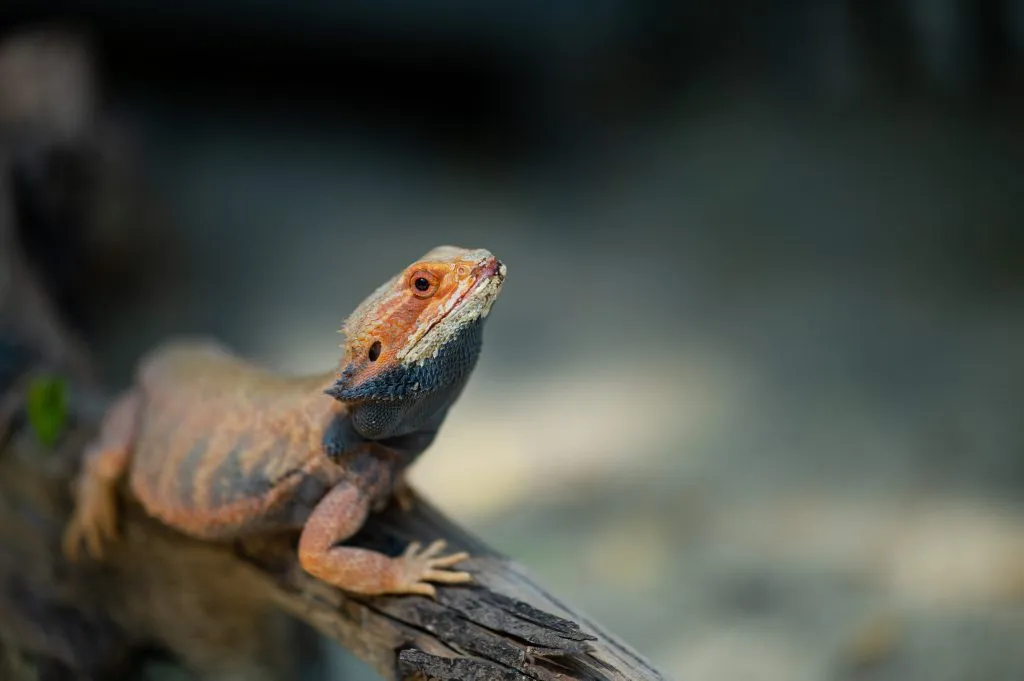
Aside from non-infectious causes of stress, there are some diseases that can cause changes in your bearded dragon’s skin.
We’ve listed some of these diseases causing skin changes in beardies below (don’t worry, we’ll explain them in more detail later):
- Mites
- Yellow fungus disease
- Dysectesis
How Can I Tell If My Bearded Dragon Is Stressed Or Sick?
Stress and sickness in bearded dragons often go hand in hand. When your beardie is sick, the chances are that they’ll also be feeling stressed.
Similarly, a stressed beardie can have a less efficient immune response, and hence be more susceptible to infection and then become sick.
Below we’ve listed some signs that a beardie is stressed:
- Hissing
- Opening their mouth wide (‘gaping‘)
- Puffing up
- Black skin or stress marks
- Changes in behavior or routine (reduced basking, appetite, activity, or bowel movements).
Don’t forget, if you notice your beardie’s skin becoming lighter, then it could just be because they are preparing to shed.
As we already mentioned, often stress in bearded dragons can be related to diseases, we’ll give some examples of specific diseases later.
Be aware that the signs of stress and sickness in bearded dragons are often pretty similar, so it could be hard to differentiate them.
We’ve listed some signs of sickness in bearded dragons below:
- Vomiting
- Discoloration or scarring of the skin
- Diarrhea or constipation
- Swellings or lumps in any area
- Dysecdysis (difficulty shedding)
- Material (discharge) from the eyes, mouth, or nose
- Sneezing
- Rapid, shallow, or open-mouthed breathing
- Lack of appetite
- Lethargy (less active than usual)
- Abnormal posture or movement
- Appearing ‘grumpy’ or hiding, reduced basking
- Dehydration (wrinkled skin, stringy saliva when opening the mouth)
- Neurological signs such as tilting their head, lack of balance, or shaking.
Disclaimer: please refer to the lists above as a guide only. If you think your bearded dragon might be sick, contact a reptile veterinarian.
Do Bearded Dragons Turn Black When Stressed?
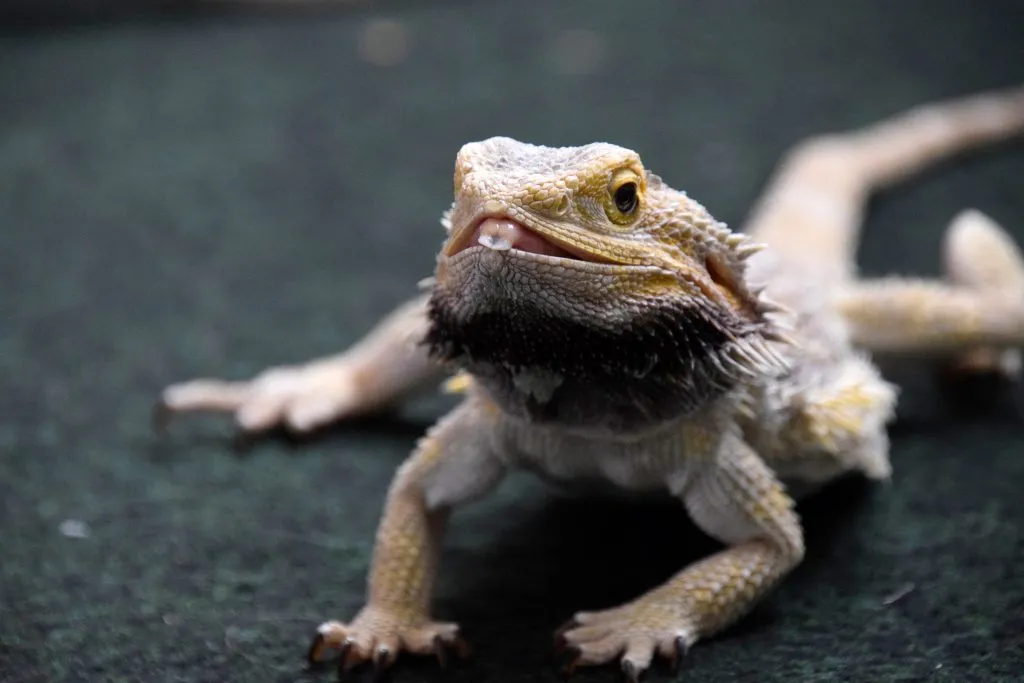
Yes, as we discussed above, a beardie who has a black beard could be stressed or sick. However, these aren’t the only reasons for a bearded dragon turning its beard black. We’ve listed some other explanations below:
- They are ready to mate
- They are shedding
- They are getting growing or getting used to their new home (baby bearded dragons)
- They want to defend their territory
- They are recovering after brumating.
Let’s take a look at what can cause a bearded dragon to feel stressed, so you can differentiate it from the above reasons.
What Causes Stress In Bearded Dragons?
So now we know what a stressed beardie looks like. If you would like to find out why your bearded dragon is stressed, have a look at the infographic below first. After that, we will explain everything in detail.
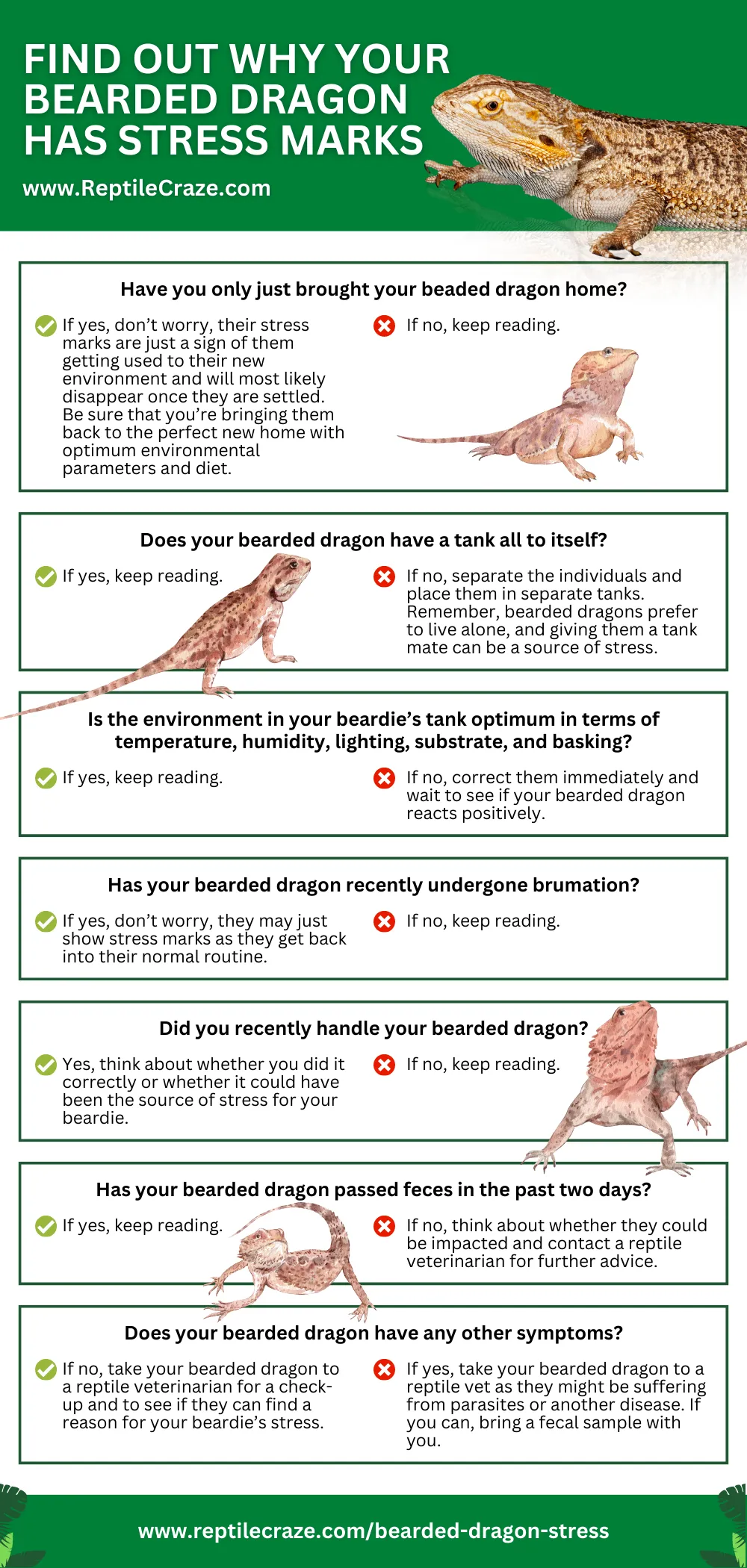
Let’s go through some reasons behind stress in bearded dragons.
1. Inappropriate Husbandry Conditions
Let’s start with one of the most common reasons for stress in captive pet reptiles, inappropriate husbandry conditions.
Unless you live and keep your bearded dragon in Australia, the chances are that you’ll need to adjust their environmental conditions to ensure they’re always comfortable.
Lighting, temperature, humidity, UVB, water, and
The good thing is, that it’s not too complicated to cater or a bearded dragon and give them its optimum environment. We’ve given a reminder of the correct parameters for a bearded dragon’s
- 120-gallon-sized
tank for an adult - Basking area with a temperature of 108 to 113 degrees Fahrenheit (Get a good heat lamp!)
- Cooler area of the
tank with a temperature between 77 and 85 degrees Fahrenheit - A decrease in
tank temperature of around 10 degrees at night - Decreased
tank lighting at night - A humidity level between 30% and 40%
- An appropriately placed UVB light (Get a good UVB light!)
- A suitable substrate and hide
Ensuring appropriate environmental conditions in your beardie’s
tank can be made easier by using digital thermometers, hygrometers, and thermostats.
It’s also important to clean your bearded dragon’s tank regularly.
This includes removing un-eaten prey items from the
It’s also not out of the question, that decorative objects in your beardie’s
When changing or updating your bearded dragon’s enclosure, try to make changes gradually and keep a close eye on your beardie, in case they become stressed.
You can read more about how to care for bearded dragons in our Bearded Dragon Care Guide: Diet, Housing, Facts.
2. Improper Handling
When it comes to handling, although you might be really excited to get some contact time with your beardie, it’s important to respect their boundaries so they don’t become stressed.
Inappropriate handling is a particularly common cause of stress in beardies, especially when their carers are inexperienced or this is their first animal.
If this is the case, as hard as it might be, give your beardie plenty of time to settle in and get used to you before you start handling them.
We’ve listed some guidelines for handling your bearded dragon below:
- Don’t surprise or grab them
- Let them crawl onto your hand rather than picking them up if possible
- Only handle them for 10-15 mins and build up handling time slowly
- Don’t handle them whilst they’re shedding, brumating, or shortly after eating
- Handle them in a quiet, calm environment that is separate from other pets.
Don’t worry, with time your beardie will get used to you and they can learn to enjoy handling time as much as you do!
You can read more about handling a bearded dragon correctly in our article ‘How Often Can Bearded Dragons Be Handled?‘.
3. Cage-mate Aggression
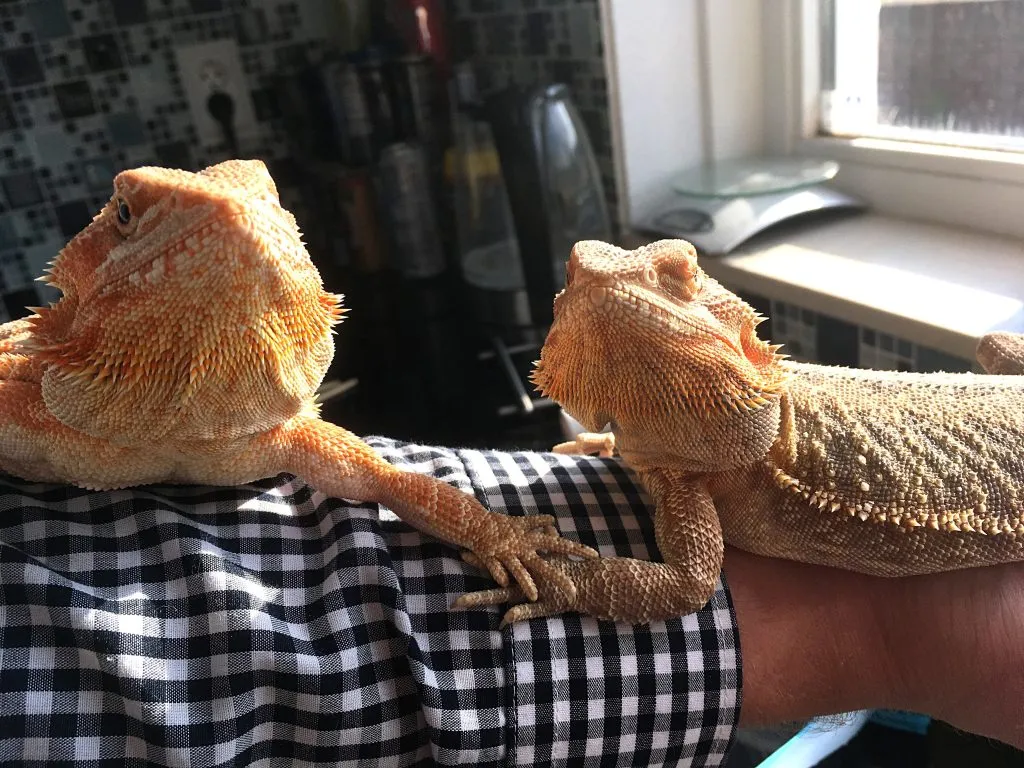
They might be super cute, but beardies are also very territorial. If you want to keep your bearded dragon happy, don’t worry about housing it together with a friend.
Usually, beardies prefer to live alone as they don’t have the stress of needing to defend their territory.
In a scenario with another individual, a bearded dragon will darken their beard and puff up in a bid to become bigger than the other beardie. This is your beardie’s way of defending their territory and is normal.
If you decide to keep two individuals in the same
You can read more about this topic in our articles ‘Can Bearded Dragons Live With Leopard Geckos?’ and ‘Why Uromastyx And Bearded Dragons Can’t Live Together’.
4. Intestinal Impaction
Impaction is caused by a blockage of some kind (such as substrate or
- Using sand as a substrate
- Feeding an inappropriate diet that is hard to digest (for example too big
food items) - Improper husbandry conditions (especially temperature).
It’s normal for bearded dragons to pass feces every one or two days. If you haven’t seen feces in your bearded dragon’s enclosure in a while they could be impacted.
We’ve listed some other possible signs of impaction below:
- Difficulty moving their hind legs
- Behavioral changes
- A swelling or lump in your bearded dragon’s back (indicating the impacted material).
Impaction can be a life threatening condition and usually requires treatment from a reptile veterinarian. If you can’t get to your reptile veterinarian straight away, you can try giving your beardie a warm soak or massaging their abdomen in the meantime.
5. Diseases
As we mentioned earlier, there are some diseases that directly affect your beardie’s skin and cause stress.
In this section, we’ve listed some diseases some of which might not affect your bearded dragon’s skin directly, but can be a source of stress:
- Yellow fungus disease – In this disease, the skin can turn yellow or yellow-brown and it can also affect internal organs. It’s thought that the disease can also be passed from beardies to humans (if immunosuppressed).
- Periocular squamous cell carcinoma
- Eye infections
- Nutritional secondary hyperparathyroidism
- Metabolic bone disease – a serious disease resulting from inadequate dietary calcium or vitamin D3.
- Mouth rot – also known as infectious stomatitis, a bacterial infection of the mouth.
- Respiratory infections – especially common in beardies with inappropriate living conditions.
- Adenovirus – especially common in young beardies, resulting in liver and gastrointestinal problems which are often fatal.
If you think your bearded dragon may be suffering from a disease such as the ones we’ve described above, contact your reptile veterinarian for a proper diagnosis and treatment.
If you want to read more about bearded dragon diseases, read our article ‘8 Signs Your Bearded Dragon Is Dying And How You Can Help’.
6. Internal Parasites
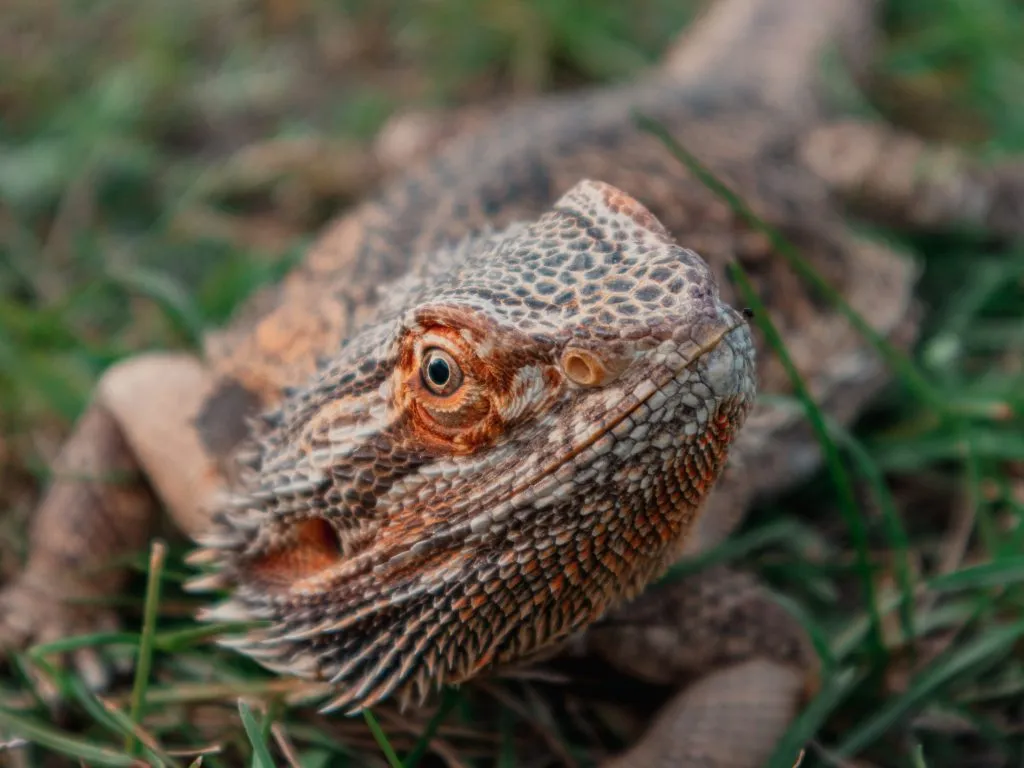
Coccidia are protozoal parasites that can live in a beardie’s intestine and is especially common in young bearded dragons. Infection with coccidia can also be in conjunction with other infections such as atadenovirus or microsporidia.
Treatment can be obtained following diagnostics on a fecal sample and a prescription from a reptile veterinarian.
If your beardie has coccidiosis, you’ll also need to disinfect their
7. Ectoparasites
Bearded dragons can suffer from 3 different types of mites (the snake mite, lizard mite, and chigger mite). It’s pretty uncommon for them to have ectoparasites, but not out of the question.
They’re pretty small, but you might be able to see them if you look closely. Ectoparasites can cause your beardie to become a bit restless and uncomfortable, although they’re not usually life-threatening.
These annoying critters can be found in folds of skin near the lips, ears, and close to the vent.
Be aware that treatment of ectoparasites, such as mites, requires a prescription from a veterinarian and thorough disinfection of your beardie’s
How To Calm A Stressed Bearded Dragon
If your beardie is showing some stress-related signs, don’t panic! There are a few things you can do at home to help alleviate stress and get your beardie back feeling its best again.
We’ve created a checklist you can work through at home:
- Check and correct all environmental parameters
- Check for potential beardie stressors
- Give your beardie a soak in a bath and then return them to their basking area
- Take your beardie for a veterinary check-up, if you can, bring a fecal sample with you
Disclaimer: Please refer to the above list as a guide only. If you think your beardie is seriously sick or stressed, it’s best to take them to a reptile veterinarian immediately for a proper diagnosis and treatment.
Conclusion
After reading this article, you have all the information you need about stress marks in bearded dragons and how to manage them.
Have you had an interesting experience with stress marks in bearded dragons? Tell us about it in the comments below!
- Enchi Ball Python: A Unique and Stunning Morph of Python regius - March 27, 2025
- Emerald Tree Monitor: The Enigmatic Green Guardian of the Rainforest - March 26, 2025
- The Egyptian Cobra (Naja haje): A Fascinating Serpent - March 25, 2025
